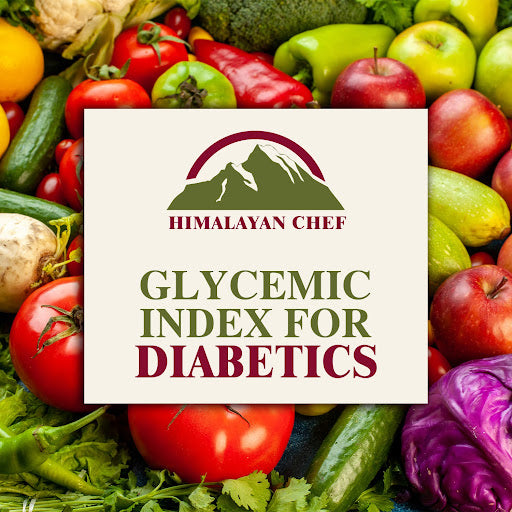Glycemic Index and Diabetes: A Complete Guide to Smarter Eating
Posted by HIMALAYAN CHEF

Millions of people in Pakistan are having trouble keeping their blood sugar levels under control because the number of people with diabetes is rising. Knowing the Glycemic Index (GI), a straightforward yet useful system that rates foods according to their impact on blood glucose levels, is one of the most successful strategies for managing diabetes. Understanding which foods to consume and avoid depending on GI can make a big impact for people who have diabetes or are trying to prevent it.
The Glycemic Index, its effects on diabetes, and the items that are best for a diabetic-friendly diet—particularly for a typical Pakistani meal plan—will all be covered in this guide. Additionally, we will present Himalayan Chef Sugar Control Flour, a nutritious flour alternative that promotes improved blood sugar control.
What is Glycemic Index?
The Glycemic Index is a number from 0 to 100 assigned to foods based on how quickly and how much they raise blood glucose levels after consumption:
- Low GI (55 or less) – Digested slowly, causing a gradual rise in blood sugar.
- Medium GI (56–69) – Moderate effect on blood sugar.
- High GI (70 and above) – Quickly digested, causing a sharp rise in blood sugar.
Why the Glycemic Index is Important for Diabetics?
For people with diabetes, the type and quality of carbohydrates matter just as much as the quantity. Carbohydrates that are high on the glycemic index causes sharp spikes in blood glucose followed by crashes, leading to unstable energy, increased hunger, and insulin resistance.
On the other hand, low-GI foods help regulate blood sugar by providing a steady release of energy, which reduces the burden on the pancreas and helps avoid complications such as:
- Heart disease
- Kidney problems
- Nerve damage
- Vision loss
Over time, adopting a low-GI diet can help improve glycemic control, reduce HbA1c levels, and contribute to weight management, which is crucial for both preventing and managing diabetes.
Low, Medium and High Glycemic Index foods
Understanding which foods fall into each GI category can help you build better meals:
Category |
Foods |
|
Low GI (< 55) |
Lentils, chickpeas, kidney beans, oats, quinoa, apples, pears, carrots |
|
Medium GI |
Brown rice, sweet corn, whole wheat bread, bananas, raisins |
|
High GI (>70) |
White bread, white rice, potatoes, sugary drinks, cakes, instant cereals |
Remember that cooking methods, ripeness, and food combinations can affect GI. For instance, overcooked pasta has a higher GI than al dente pasta, and ripe bananas have a higher GI than less ripe ones.
Health Benefits of Using Glycemic Index
Understanding and applying the Glycemic Index in your daily meals offers a wide range of health benefits — not only for people with diabetes, but for anyone aiming to live a healthier life. Here are the key advantages:
1. Better Blood Sugar Control
Foods with a low GI digest more slowly, which causes glucose to enter the bloodstream gradually. This makes it easier to manage diabetes and lower insulin resistance by preventing abrupt spikes and dips in blood sugar levels.
2. Lower Risk of Type 2 Diabetes
Regular consumption of low-GI foods may lower the incidence of type 2 diabetes, according to studies, particularly in people with metabolic syndrome or pre-diabetes.
3. Effective Weight Management
Because low-GI foods promote satiety and reduce hunger cravings, they can help with portion control and long-term weight loss. They’re also less likely to trigger binge eating or emotional snacking.
4. Sustained Energy throughout the Day
Unlike high-GI foods that cause an energy crash, low-GI meals provide a steady stream of energy, keeping you more focused, alert, and productive throughout the day.
5. Heart Health Protection
Low-GI diets are linked to improved cholesterol levels, reduced inflammation, and lower blood pressure — all of which are crucial for maintaining a healthy heart.
6. Improved Digestive Health
Many low-GI foods like legumes, fruits, and whole grains are rich in fiber, which supports healthy digestion, regular bowel movements, and gut microbiome balance.
5 ways to Use Glycemic Index Everyday
Choose Low GI Carbs - Focus on eating full, unprocessed foods, including fruits like apples and berries, whole grains, legumes, and non-starchy veggies. Use brown rice, quinoa, or whole grain bread instead of high-GI foods like white rice and white bread.
Pair Foods Wisely - The GI of a meal is decreased when carbohydrates are combined with fiber, protein, or healthy fats to slow down digestion. For instance, combining fruit with almonds or rice with lentils can lessen the effect on blood sugar.
Be mindful of Portions - Even low-GI foods can cause blood sugar spikes if eaten in large amounts. Portion control is key, especially for carbohydrate-rich foods.
Avoid highly processed Carbs - Refined and packaged foods are often high-GI due to their lack of fiber and nutrients. Opt for whole-food alternatives and check labels when possible.
Plan Balanced Meals - A balanced plate that includes lean protein, healthy fats, fiber, and low-GI carbs can stabilize blood sugar and improve insulin sensitivity.
Meal Plan for Blood Sugar Management in Pakistan
Here's an example of a balanced daily menu using the glycemic index as a guide:
Breakfast:
- 2 multigrain rotis made with Himalayan Chef Sugar Control Flour
- 1 boiled egg
- 1 cup unsweetened chai (with low-fat milk)
Lunch
- Brown rice (small serving)
- Chana daal
- Mixed vegetable curry
- Salad and raita
Snack
- Handful of roasted makhanay
- 1 apple or guava
Dinner
- Multigrain roti
- Grilled chicken breast
- Saag or lauki bhujia
- 1 cup of unsweetened lassi
This meal plan is rich in fiber, protein, and complex carbs — all of which support stable blood sugar levels.
Buy Best Sugar Control Flour Brand in Pakistan
Managing diabetes doesn’t mean giving up your favorite roti — it just means choosing the right kind of flour. Himalayan Chef Sugar Control Flour is an excellent option for those seeking better blood sugar control without compromising on taste or tradition.
Key Features:
- Low Glycemic Index ingredients for slower sugar absorption.
- Made from whole grains and high-fiber components.
- Helps in managing insulin resistance and maintaining satiety.
- Ideal for preparing soft, tasty, and healthy rotis.
Unlike regular wheat flour, this specialized flour is formulated to support diabetic health goals while fitting seamlessly into your everyday desi meals. Order now!
TAGS:
SHARE:


